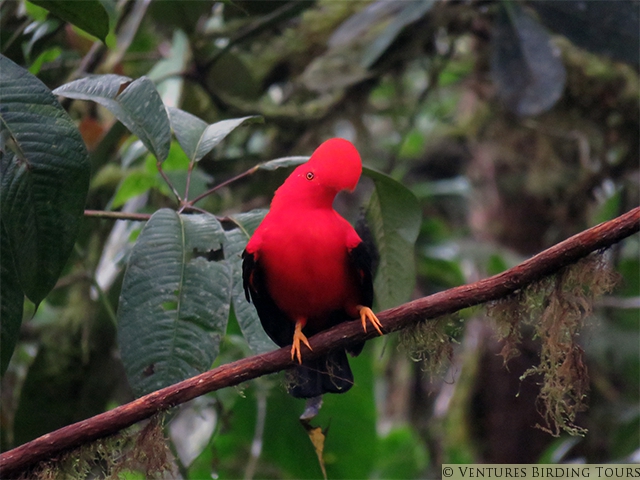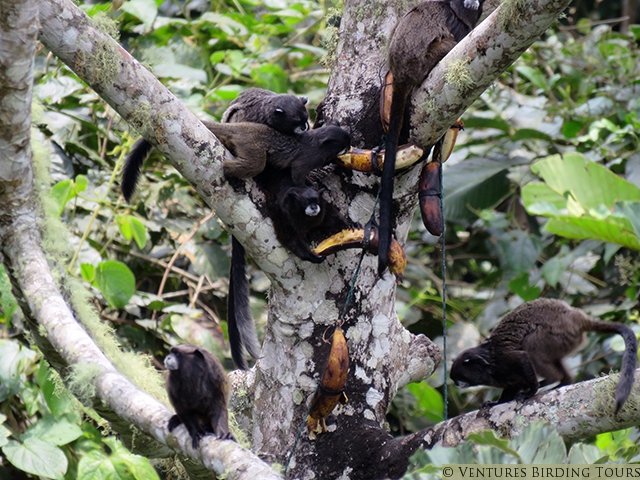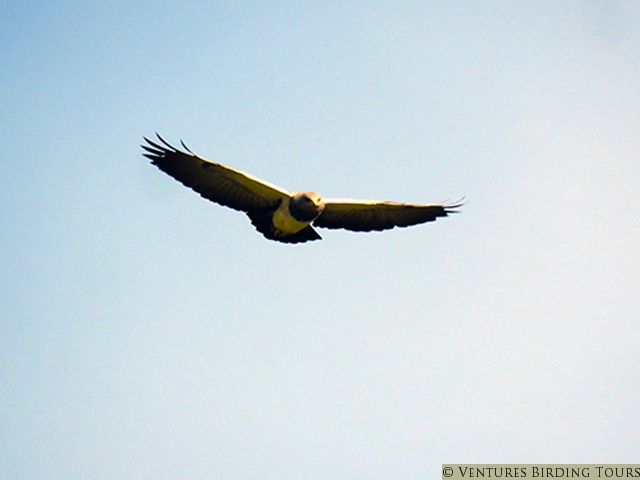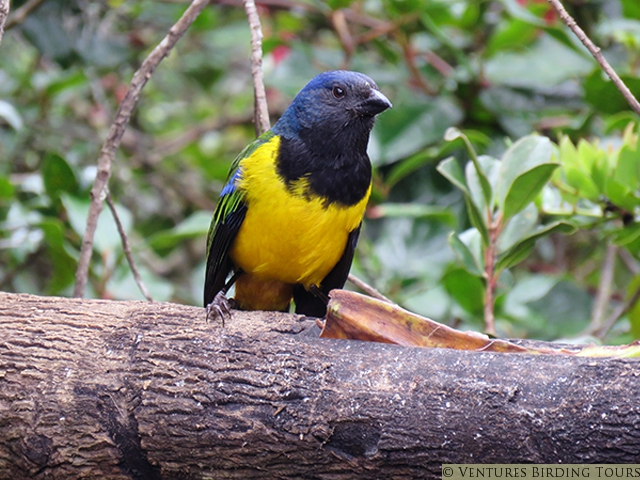February 1 Quito
Most folks arrived in Quito a couple of days prior to the tour to relax and rest after the international flight and spend some time enjoying the city. It’s about 45 mins from the new airport to the very comfortable Hotel Quito just outside of the city center.
February 2 Quito to Antisana
Breakfast was on the top floor overlooking the city and the nearby volcanos. The garden had a few birds, most notably being Sparkling Violetear, Great Thrush, Eared Dove and the abundant Rufous-collared Sparrows. A nice surprise was a pair of Tropical Mockingbirds – a newly-arrived bird that’s expanding its range into Quito. We meandered our way through Quito and headed towards the east slope. Our first night would at one of the highest stops of the trip and with a spectacular view from the lodge overlooking a deep valley and steep rocky cliffs. Andean Condors roost on the cliffs opposite the lodge and immature # 15 was in view before lunch! Also a stunning Black-tailed Trainbearer flew in allowing all of us to enjoy this great hummer. As weather conditions can change suddenly and it was currently clear, we decided to head into Antisana National Park and have a late lunch. Roadside birding here is easy and we soon had both Cinclodes, plenty of Carunculated Caracara and both Andean Ibis and Ibis Lapwing. A couple of stops (somewhat cold and windy) at Laguna la Mica produced some of the very few ducks of the trip – Andean Teal, Yellow-billed Pintail and Andean (Ruddy) Duck. There are usually a few Silvery Grebes on the lake and it’s always good to see this lovely bird. After an enjoyable lunch back at Tambo Condor we hiked down to our rooms (phew!) and spent time taking photos of hummingbirds at the feeders – Giant, Sparking Violetear, Tyrian Metailtail and Shining Sunbeam.
February 3 Antisana to Wildsumaco
It’s a full day drive (with birding stops) across the mountains and down the east slope to Wildsumaco Lodge. After some early morning birding near the amazing lava flow where we had our first sighting of the awesome (truly!) Sword-billed Hummingbird and several Red-crested Cotingas, we continued towards lunch in Baeza. A stop along the river in Cosanga was a bust for Torrent Ducks, but we did find a very obliging pair of Torrent Tyrannulets and a pair of striking Southern Lapwing. As we started to descend into the lowlands we made the obligatory stop near the quarry for great views of Cliff Flycatcher and a Fasciated Tiger-Heron was seen perched atop a large rock in the Cascada Hollin. It was getting late now so we only made a couple of stops along the Sumaco Road on our way to the lodge, adding some typical birds of the area including: White-throated Toucan, Violaceous Jay, Russet-backed Oropendola and Blue-gray Tanager (this race with white shoulders) before checking into the very comfortable lodge and a well-deserved beer. We would have to wait until the morning to see what hummers were coming to the feeders!
February 4 Wildsumaco
We awoke with lots of anticipation for a great day and after an early breakfast we staked out the new moth sheet to see what birds were coming in for their breakfast. Several of these birds allowed excellent views, although the lighting was not really good enough for photos. Some of these included: Collared Trogon, Peruvian Warbling-Antbird, Black-faced Antbird, White-backed Fire-eye and Lined Antshrike – great to be able to see several antbirds at our leisure! We spent some time around the feeders where the most abundant hummer was Golden-tailed Sapphire. Others included: Black-throated Brilliant and Gould’s Jewelfront and the delightful (Peruvian) Booted Racket-tail; this race with the orange “booties”. We decided to start the day with some easy walking down the gravel road to see some of the edge and open country species; several Yellow-tufted Woodpeckers were perched atop the dead branches and a pair of Military Macaws flew overhead. One of the most enigmatic birds of Wildsumaco (and the logo of the lodge) is the uncommon Coppery-chested Jacamar. After hearing one calling for a while we amazingly found it through a hole in the thickets perched on a vine. A few Paradise, Blue-necked and Spotted Tanagers fed in the fruiting trees and it was fun to see some of “our” birds, such as Scarlet Tanager, Canada and Blackburnian Warblers and loads of Swainson’s Thrushes – surely one of the most abundant species in the area. The afternoon was doing some forest trails, so some of the group decided to stay and watch the feeders instead. Wildsumaco, like many Neotropical birding locations, has an antpitta feeding station, where we sat comfortably and waited for the action to start. Both Plain-backed and Ochre-breasted Antpittas came in for their worms, as well as a locally rare Gray-cheeked Thrush. It was probably the same bird that was present last year and has learned how to get easy food! A family of Rufous-breasted Wood-Quail played very hard to get and a roosting Band-bellied Owl was a lot more cooperative. It was then back to the lodge where we could relax on the porch and watch the hummers before dusk and dinner.
February 5 Wildsumaco to Papallacta Hot Springs
Two nights is too short a stay at Wildsumaco so we had to make the most of our last morning here. Once again we started the day at the moth sheet, where the birds cooperated nicely. The same suite of antbirds were there again, but joined by a pair of Yellow-breasted Antwrens this morning and a very obliging Buff-fronted Foliage-gleaner. A Black-and-white Warbler played around in the background and a pair of Squirrel Cuckoos showed fairly well. An uphill walk along the road after breakfast was terrific when a Buckley’s Forest-Falcon carrying a lizard flew across the road. It did pause for a second, but not alas in the open. A crisp and beautiful male Cerulean Warbler was feeding in some vines and a pair of Military Macaws most probably had a nest in a distant palm. Scarlet Tanagers were moving through and it was great to see so many brightly-colored males in one tree. Unfortunately we had to leave after lunch and head back west across the mountains. We had the White-tailed Hillstars at Casa Susanita and the Torrent Ducks at Cosanga – the latter involved a lot of balancing on the rocks or teetering at the cliff edge to get good views. We got to our cushy rooms at Papallacta Hot Springs before dark and yes, we all had to enjoy the waters before or after dinner. It certainly feels good to soak and ease the road-weary bones…..plus chat to Juan’s son who joined us for dinner.
February 6 Papallacta to the west slope
It was a chilly morning at Papallacta and we checked the river again for White-capped Dipper. Unfortunately it was only seen by some of the group as it flew under the bridge and around the corner. We had more luck with the small flock of Spectacled Redstarts and Cinereous Conebills that fed in the flowering shrubs. It was then down to the lovely Guango Lodge for another selection of hummer feeders. Different species appear as one goes up and down in elevation on both slopes and we had several new species here at Guango. Tourmaline Sunangels, Buff-tailed and Chestnut-breasted Coronets were abundant, with smaller numbers of White-bellied Woodstar, Mountain Velvetbreast and Collared Inca. A walk along the river and through a patch of Alder forest produced a small mixed flock including Powerful and Crimson-mantled Woodpeckers, Mountain Cacique and Pearled Treerunner. It was very cloudy and windy up at the radio antennas as we searched in vain for the often-elusive Seedsnipe. It was elusive again today, but a Red-rumped Bush-Tyrant was a nice bonus as we drove downhill. We had to go through Quito on our way west and Juan did well to find us a nice restaurant for lunch near the airport. The lunch selection was quite different and this may make a convenient place to stay for an airport connection. A nice addition was a singing male Golden Grosbeak in the parking lot as we boarded the van – and then we had to offload again! It was then all downhill from here as we drove west and downslope through Mindo on our way towards Los Bancos. The rain started now and was quite heavy as we approached our hotel. We had dinner first and a “mix-up” had us staying at a different hotel that night. The staff did their best to make us comfortable but it wasn’t what we were expecting. Thankfully Juan did his magic and we spent the next 4 nights at Septimo Paraiso Lodge in Mindo.
February 7 Antpittas, San Tadeo and Septimo
It was an early start today as we drove to Angel Paz’s famous “Antpitta farm”. We started with a dawn visit to a lek of the amazing Andean Cock-of-the-rock. Just to stand there listening to the raucous calls of these brilliantly-colored birds is very atmospheric, and then to watch the flame-orange males call and fly into patches of open forest – wow! Angel Paz is renowned for starting the feeding of Antpittas, notably a Giant Antpitta named Maria. With Maria’s progeny now filling her “shoes”, we had excellent views of Chestnut-crowned and Yellow-breasted but the Giants were away this year. The supporting crew of Dark-backed Wood-Quail, Olivaceous Piha and female Lyre-tailed Nightjar adding to an excellent morning. Visiting Angel’s place is always a truly incredible experience as Angel’s wife produced some delicious snacks before we left to visit yet more feeders. The feeding station at San Tadeo was incredible with the owner having built extravagant water features, as well as a whole bevy of fruit and seed feeders. Needless to say the show was wonderful with lots of tanagers, as well as Red-headed Barbet, Ecuadorian Thrush and 2 Mourning Warblers in the hedgerow, the latter quite unusual this far south. The afternoon gave us time to relax, although Septimo does have a nice selection of hummer feeders and some of us enjoyed spending some time here as well as walking around the grounds.
February 8 Reserve Amagusa and Oilbird Cave
Another early morning today as we head west towards the Choco habitat. It takes a couple of hours to get to the Mashpi area and the wonderful Amagusa Reserve. The entrance road can be excellent especially as we started out with a very obliging Golden-headed Quetzal! This was quickly followed by Indigo Flowerpiercer and Orange-breasted Fruiteater – some excellent Choco species. Another nice surprise was an adult Ornate Hawk-Eagle that flew up to a nearby tree – wow. We spent the next couple of hours and had our picnic lunch at the hummer and fruit feeders. The hummer show was crazy with the most abundant being the stunning Velvet-purple Coronet. Empress Brilliants and Purple-bibbed Whitetips were also common with a total of 15 species seen at the reserve this morning. After a well-deserved ice-cream break we drove down the Oilbird Cave where we enjoyed some great views of these unusual birds. It was a fairly long drive back to Septimo and there was a fair amount of napping going on after a long day. The staff at Septimo do a wonderful job and the food and atmosphere made for a very relaxing evening.
February 9
It was over to Milpe this morning. This preserve protects a large tract of cloudforest on the edge of the Choco and has a nice network of trail (some steep!), as well as a place to sit out of the rain and watch the hummer feeders and a nice gift shop. Add some coffee to the mix and it was the perfect recipe for a nice morning. It was good to sit and watch the hummers and put into practice all of the identification techniques we have learned over the last week. A pair of Collared Aracaris had a nest hole nearby so we could watch them watching us! Several of us walked some of the trails to find the bizarre-sounding Club-winged Manakin which we watched making its very strange wing sounds, but unfortunately the Golden-winged Manakin eluded us on our hike into the forest. We decided to drive the nearby eco-route in the afternoon, but the clouds and rain prevented us seeing very much. A small flock which moved in and out of the fog did have Cinnamon Flycatcher, Buffy (Pacific) Tuftedcheek, a female Green-and-black Fruiteater and a pair of the beautiful Plate-billed Mountain-Toucans.
February 10 Septimo to Yanacocha and Quito
After a pre-breakfast walk when we heard way more than we saw we unfortunately had to leave Septimo and slowly head back towards Quito. Our main birding stop of the day was the high elevation reserve at Yanacocha which is situated at 14,000’ in elevation. Thankfully the main trail was very level so we only needed to walk the mile to the feeders near the tunnel. Also the feeders near the main building were also very active so some of the group decided to stay put. This is the place to see the Sword-billed Hummingbird and they came to the feeders fairly often, along with Shining Sunbeam, Sapphire-vented Puffleg and Buff-winged Starfrontlet. And who would have expected the Short-eared Owl that was sitting on a post on the side of the road on the way down? Unfortunately we had to leave after our picnic lunch to drive back to Quito. Most of our flights were late in the evening, so we had a relaxing dinner at Puembo Birding Garden before catching our homebound flights.
We finished the tour with over 330 species of birds, of which 53 were hummingbirds. From the largest hummingbird in the world, the Giant, to the longest billed, the Sword-billed, we had a great variety of species – most seen very well indeed. Many, if not all, of the lodges now have feeders which allow great views of these often tough to see birds. Thanks to Juan and all of the great folks we met throughout the tour. We will definitely be returning.







